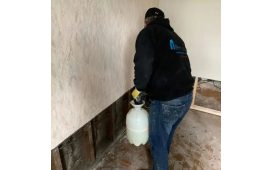Flea infestations are a common nightmare for homeowners, particularly those with pets. These tiny pests can quickly become a major problem, not only for your furry friends but for your entire family. In fact, fleas can easily find their way into your home and multiply at an alarming rate, causing discomfort and potential health issues. So, understanding the signs of a flea infestation and knowing when to seek professional Pest Control Services in Belleville can help you tackle the problem before it spirals out of control.
Here are seven signs that might indicate your house is infested with fleas.
1. Excessive Scratching and Grooming by Pets
One of the first signs of a flea infestation is your pets scratching themselves more than usual. Fleas bite to feed on blood, and their bites can be intensely itchy for animals. So, if you notice your dog or cat constantly scratching, biting, or grooming themselves, it could be a reaction to flea bites. In such cases, check your pet’s skin for red, irritated patches or hair loss, which could indicate a flea allergy.
2. Visible Flea Dirt
Flea dirt, which is actually flea feces, resembles tiny black pepper flakes and can be spotted on your pet’s skin or in areas they frequent. To confirm if the black specks are indeed flea dirt, moisten a paper towel and dab the specks. If they turn a reddish-brown color, it’s flea dirt, as this is digested blood. In fact, this is a clear sign that fleas are present and feeding on your pets.
3. Bites on Humans
Fleas will bite humans as well. If you or your family members notice itchy, red bumps on your ankles, legs, or other exposed skin, then fleas might be the culprits. These bites often appear in clusters or straight lines and can be quite irritating. So, if everyone in the household is experiencing similar symptoms, it’s time to investigate further.
4. Sightings of Live Fleas
While fleas are small and can be difficult to spot, seeing even one should be cause for concern. In fact, fleas are typically about 1/8 inch long, reddish-brown, and move quickly. You might catch a glimpse of them hopping around on your pet, your carpet, or furniture.
5. Finding Flea Eggs
Flea eggs are tiny, white, and oval-shaped, often found in the places your pets spend the most time. They are about 0.5 mm in size and can be hard to see with the naked eye. A magnifying glass can help in spotting them in your pet’s bedding, carpets, or upholstery. Remember, discovering flea eggs indicates an active infestation that needs immediate attention.
6. Pets Are Restless
Fleas cause discomfort, leading to restlessness in pets. If your normally calm pet is agitated, unable to settle, or constantly moving around, then fleas could be the reason. You should pay attention to changes in behavior, such as increased pacing or reluctance to lie down, as these can be indicators of flea discomfort.
7. Flea Larvae and Pupae
In the cases of severe infestations, you might come across flea larvae or pupae. Larvae are small, white, worm-like creatures that feed on flea dirt, while pupae are cocoons that house developing fleas. In fact, finding them in your home suggests a well-established infestation that requires comprehensive treatment.
How to Handle a Flea Infestation?
To confirm a flea infestation, use a fine-toothed flea comb on your pets, inspecting the comb after each stroke for fleas or flea dirt. In addition, place a shallow dish of soapy water under a night light; fleas are attracted to the warmth and can jump into the dish, confirming their presence.
If you suspect fleas, start by thoroughly vacuuming your home, focusing on carpets, rugs, and pet bedding. Wash your pet’s bedding in hot water. It is also essential to treat your pets with veterinarian-recommended flea treatments and consider using flea sprays or powders. Remember, consistent cleaning and treatment can help manage the infestation.
Conclusion
Fleas can be persistent and challenging to eliminate completely. If your efforts are not yielding results, it might be time to consult professional pest control services. They can provide more comprehensive solutions to ensure your home is flea-free.
Don’t let fleas disrupt your home life—take action at the first sign of infestation and protect your family and pets from the discomfort these pests cause.











